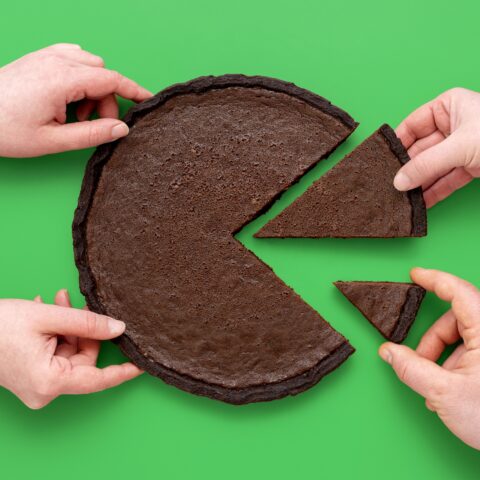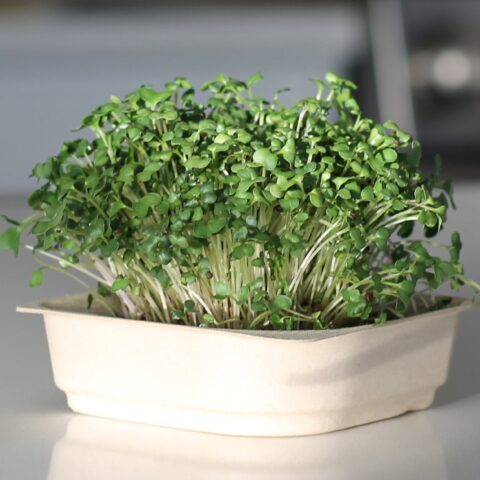How to Practice the Paleo Diet®
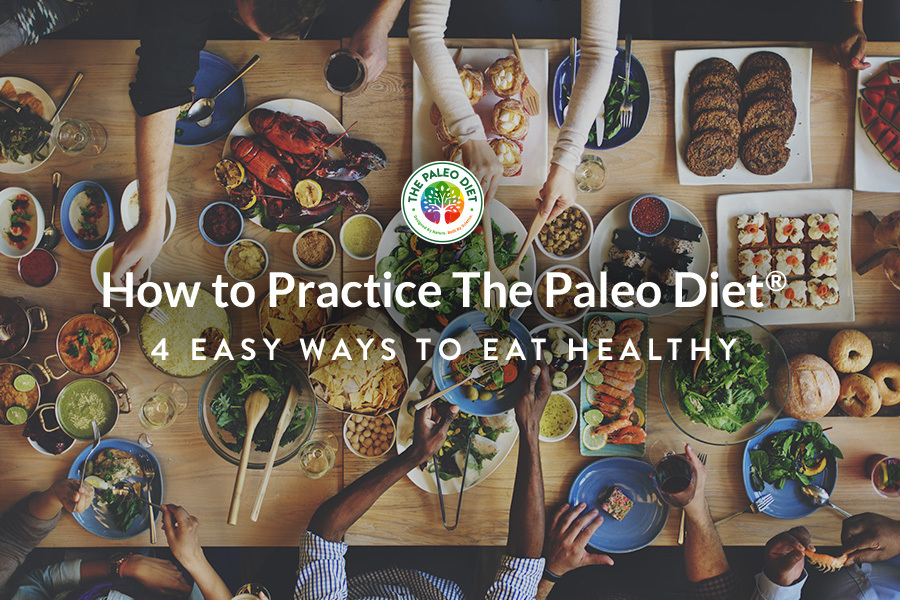
For over 20 years, Dr. Loren CordainTM has shared simple guidelines for how to practice The Paleo Diet®. Today, we share several flexible ways to approach Paleo eating and make it your own. For most people, it’s unnecessary and unrealistic to eat 100% Paleo foods 100% of the time. According to research and clinical experience, most people can enjoy the full health benefits of Paleo eating by choosing Paleo foods 85% of the time and satisfy cravings by indulging in non-Paleo treats for no more than 15% of their foods. But what if you are just getting started with The Paleo Diet® or if your eating habits are already pretty healthy? These four new Paleo Diet® guidelines are inherently flexible so you can customize your healthy eating to meet your unique needs. Let’s explore how to practice The Paleo Diet® to meet a variety of needs, cooking scenarios, and lifestyles.
Reflecting on 20 years of The Paleo Diet®
Let’s back up a sec and revisit the basics of The Paleo Diet®.
If you’re new to The Paleo Diet® concept or could use a refresher, you might be wondering: Is it healthy and sustainable? What are the benefits of The Paleo Diet? How long do they take? Which foods should I eat, and which should I avoid?
Dr. Loren CordainTM went a long way toward answering these questions in his groundbreaking 2002 book The Paleo Diet. His book was the synthesis of over 10 years of research covering thousands of peer-reviewed nutrition studies from top scientists in the field.
Since then, we have learned even more about the science and practice of Paleolithic nutrition.
Most People Don’t Need to Be 100% Paleo
We know it’s tough to eat Paleo 100 percent of the time, and we’ve never recommended that anyone try, unless it’s part of a short-term reset or for the long-term support of a medical condition like an autoimmune protocol diet.
So why not eat 100 percent Paleo, all the time? First, while our hunter-gatherer ancestors didn’t have donuts, soft drinks, and other processed foods at hand, they did occasionally eat unhealthy foods like grass seeds. Our bodies have evolved to handle a certain amount of less-than-optimal foodstuff, as long as it’s kept to a small percentage of what we eat. In fact, many nutrition scientists and immunologists feel it’s beneficial to challenge the body’s digestive and immune systems with minor irritants to help keep systems regulated, primed, and functioning at their best. That means a few treats every now and again might actually be good for you!
Secondly, trying to stay 100 percent Paleo in today’s fast-paced world is just too challenging for most people, and too likely to cause frustration and failure. That’s not how we want you to feel about food, eating, and health.
We want The Paleo Diet® to be a positive force of inspiration, not a source of disappointment. We would much rather see you sustain a Paleo way of eating for a lifetime of health. After all, The Paleo Diet® is not intended to be a short-term diet, it’s a lifestyle that unlocks years of better health through smarter eating.
The Original 85-15 Rule: 85% Paleo, 15% Whatever

We’ve learned that the best way to sustain The Paleo Diet® for a lifetime is through flexibility. Dr. Cordain’s first book introduced the 85-15 Rule, which encouraged followers to eat Paleo 85 percent of the time and eat whatever they want 15 percent of the time.
The 85-15 Rule sounds simple in theory, but putting it into practice has been a source of confusion for some. Should the percentages be measured by volume, or by calories? Or should it be broken down by meals per week? To help clear up the confusion, we’re recommending a new way to build flexibility into your Paleo diet.
Enter: TRUEPALEO™ and PaleoFLEX™ Meals
As part of our 20-year celebration of Dr. Cordain’s founding of The Paleo Diet®, we have launched a new brand licensing and food certification program. Soon, you will begin to see TRUEPALEO™ and PaleoFLEX™ foods certified by The Paleo Diet® that will make it easier to find healthy, Paleo-approved foods in grocery stores and online.
In the meantime, we are categorizing our own catalog of free, online Paleo recipes with indicators of which are TRUEPALEO™ and which are PaleoFLEX™.
TRUEPALEO™ recipes are 100% compliant with Dr. Cordain’s original Paleo Diet® guidelines for health. PaleoFLEX™ recipes are healthier than most mainstream recipes, but they offer a little more flexibility for sweeteners, sodium, and other additives.
See more on TRUEPALEO and PaleoFLEX foods.
Four Simple Ways to Practice The Paleo Diet®
TRUEPALEO™ and PaleoFLEX™ make it easier to think about how to practice Paleo eating.
The benefits of The Paleo Diet® fall along a spectrum. For most people, higher compliance brings more health benefits.
Since it can get confusing trying to break down your diet by percentages, our science team recommends counting meals per week broken down by TRUEPALEO™, PaleoFLEX™, and non-Paleo meals.
If you’re new to The Paleo Diet®, start at the Entry-Level and slowly increase compliance over time. This gives you time to learn how to follow Paleo principles, shop and cook Paleo foods, and discover Paleo flavors you enjoy —while you’re rewarded with positive changes to your health.
Entry-Level Paleo
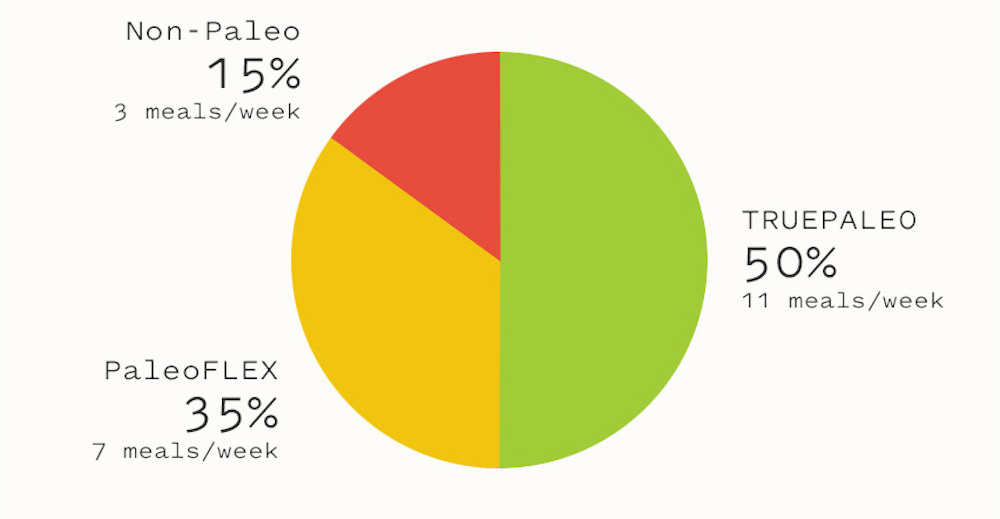
Start here, unless you need a more assertive treatment for a medical condition.
Entry-Level Paleo means:
- Only Paleo foods (aka TRUEPALEO™) for half your meals for the week, which is about 11 meals.
- PaleoFLEX™ foods (a little more sugar, sodium or additives) for about 35 percent of meals, which is seven meals per week.
- Non-Paleo foods—whatever you want! — for 15 percent, or three meals per week.
The Paleo Diet® is flexible, and there are many ways to put this into practice. To find what works best for you, try one of these meal plan concepts.
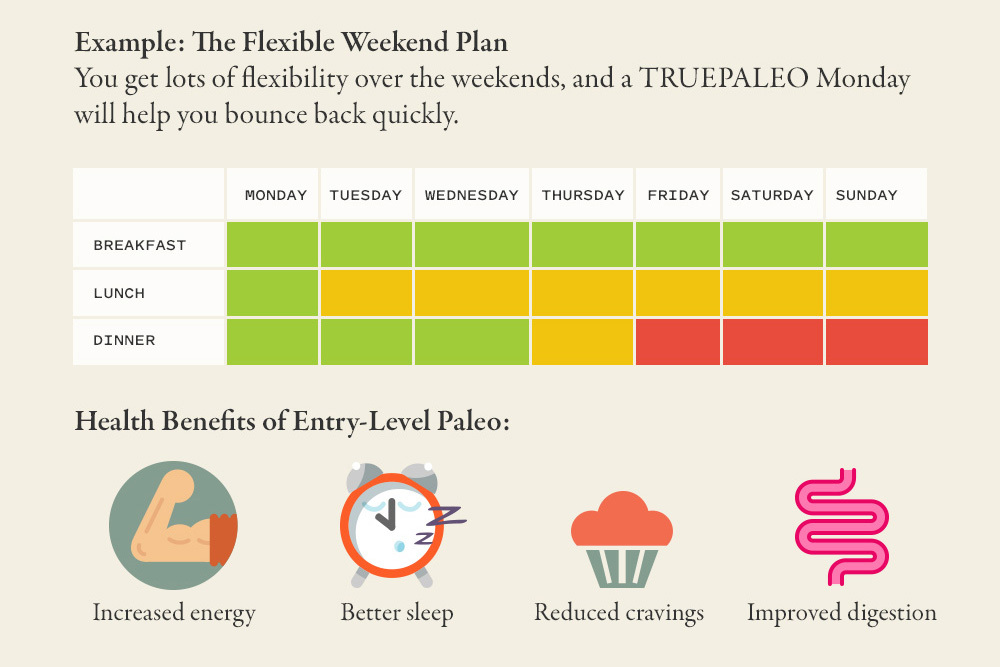
Of course, there are many other ways to mix and match TRUEPALEO™, PaleoFLEX™, and Non-Paleo meals. As long as you’re hitting the 11-7-3 ratio of 11 healthiest, 7 healthy, and 3 treat meals per week, you should notice changes in how you feel within a week or two.
Realistically, we know you will find the rhythm of meals that works for you based on your lifestyle, your schedule, and how you feel. This Entry-Level Paleo is a great starting point for anyone who wants to try The Paleo Diet® and start to feel the benefits over time.
The Health Benefits of Entry-Level Paleo
We know from research that higher compliance with The Paleo Diet® brings more benefits, but most people at entry-level Paleo compliance will enjoy these benefits to some degree:
- Increased energy
- Better sleep
- Reduced cravings
- Weight loss
- Improved digestion
Mid-Level Paleo
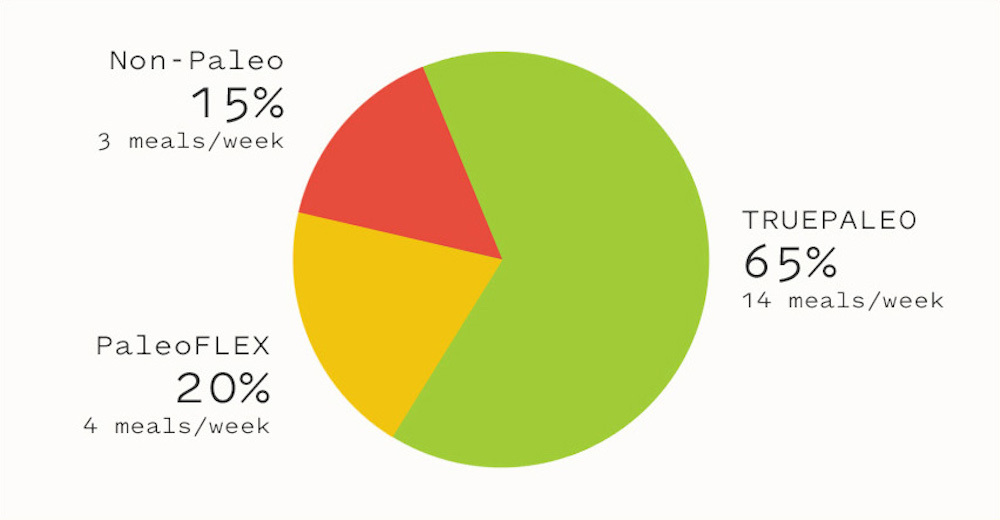
Some people stay at Entry-Level Paleo for the long term because they feel good, and the diet is working for them. If that’s you, then feel free to stay right where you are!
If you seek more health benefits and feel comfortable with shopping, cooking, and counting Paleo meals, then turn up the dial by swapping out three PaleoFLEX™ meals for TRUEPALEO™.
Mid-Level Paleo means:
- Only Paleo foods (aka TRUEPALEO™) for about two-thirds of your meals each week, which is about 14 meals.
- PaleoFLEX™ foods (a little more sugars, sodium or even an additive) for about 20 percent of meals, which is four meals per week.
- Non-Paleo foods—whatever you want!—for 15 percent, or three meals per week.
This level of Paleo eating is arguably easier for counting meals. One way to do it is to ensure that two meals of every day are TRUEPALEO™.
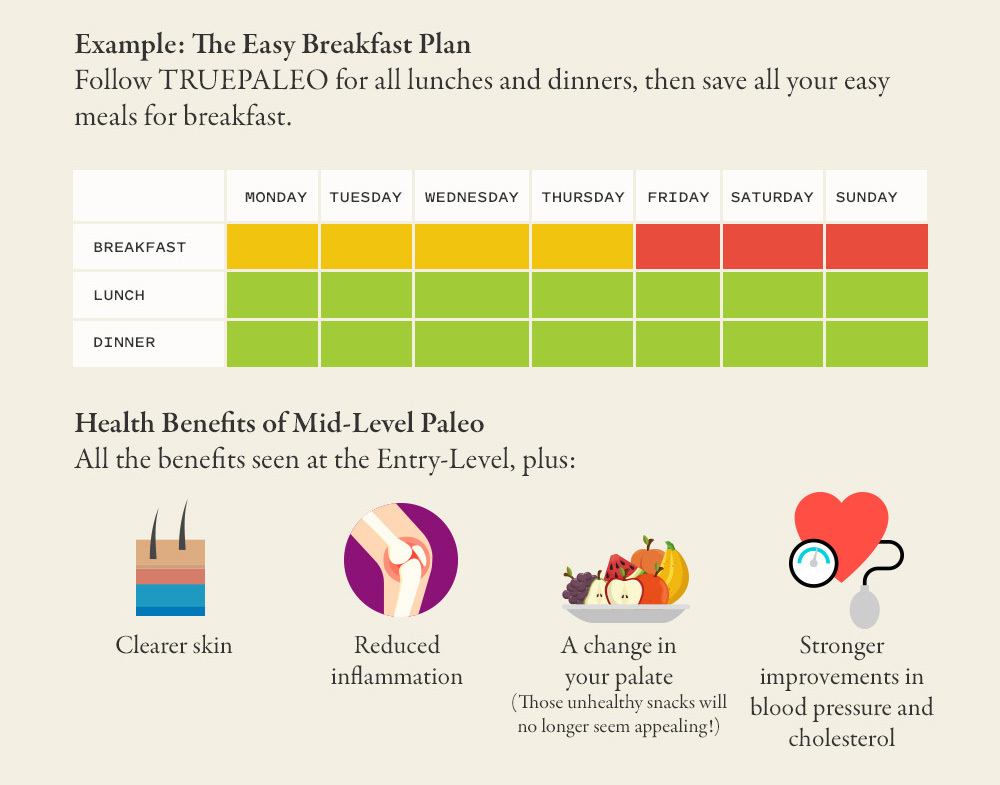
As long as you hit your ratio of 14 TRUEPALEO™, four PaleoFLEX™, and three open meals, you are practicing Mid-Level Paleo.
Top-Level Paleo
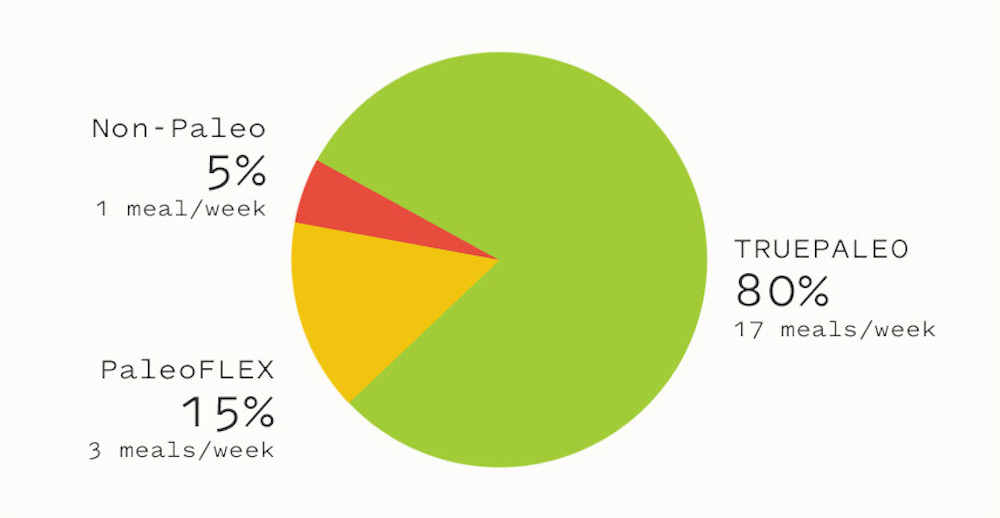
At this level of Paleo eating, it’s truly a lifestyle. It may sound tough to sustain, but research shows that 45 percent of Paleo Diet® followers report having practiced The Paleo Diet® for five or more years. (1) This truly is the veteran level!
Top-Level Paleo means:
- Only Paleo foods (aka TRUEPALEO™) for 80 percent of meals per week, which is 17 meals.
- PaleoFLEX™ foods (a little more sugars or sodium or natural additives) for about 15 percent of meals, which is three meals per week.
- Non-Paleo foods—whatever you want!—for 5 percent, or one meal per week.
Practicing Top-Level Paleo might be simplest of all in the sense that you are eating only TRUEPALEO™ foods almost all the time.
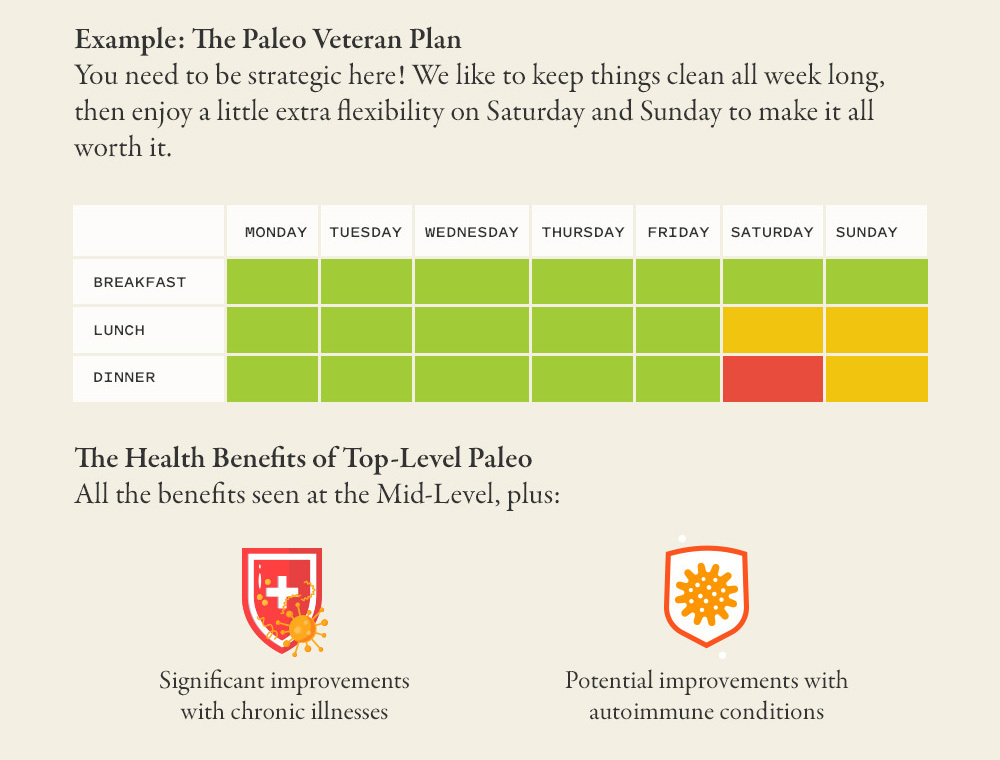
TRUEPALEO™ (100% Paleo all the time, similar to the Autoimmune Protocol)

Eating 100 percent Paleo all the time is a modern version of the diet our ancestors ate before the invention of agriculture. This diet is rich in vegetables, fruits, seafood, natural meats, some nuts and seeds, and limited natural sugars, and it completely avoids added sodium, grains, legumes, dairy, GMO/bioengineered foods, and additives.
This level of Paleo eating is usually only practiced by people who have a serious medical condition and need to avoid inflammatory foods, or who have other metabolic conditions that can be influenced by diet.
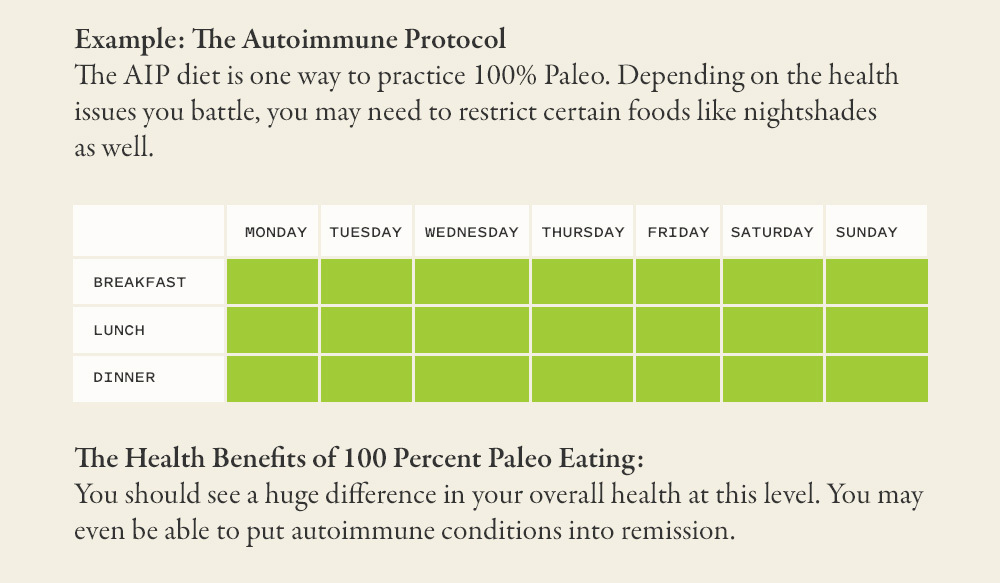
How do I count snacks, appetizers, and desserts?
You’ll want to keep snacks, appetizers, and desserts in line with the main meal that you’re eating. So, if your dinner is TRUEPALEO™, stick with a bowl of sliced strawberries for dessert. If you’re enjoying a PALEOFLEX™ lunch, enjoy a snack between lunch and dinner with a PaleoFLEX label on it, or one of the PaleoFLEX™ snack recipes from our site. This will help keep your diet ratios in proportion without the need to do any extra calculations!
The Paleo Reset
Paleo Diet® followers tell us that, now and again, they need to crack down on their eating habits through a Paleo Reset. A Paleo Reset is a short-term practice of higher-than-normal compliance with The Paleo Diet®.
A 7-day or 28-day 100 percent Paleo Reset can help ease bloating, skin problems, weight gain, and inflammation after a big vacation, holiday eating, or stressful times of life when eating healthy took a backseat to other priorities.
The occasional Paleo Reset works nicely and members of our team do it now and again, too.
If you would like to explore a Paleo Reset, take a look at our free 7-Day Paleo Reset and our affordable 28-Day Paleo Reset programs, available as downloads from our website’s Resources section.
Customizing The Paleo Diet® for You
How do you practice The Paleo Diet®? Write to us at help@thepaleodiet.com or leave a comment on Facebook, Instagram, or Twitter to share the ways you make The Paleo Diet® your own, healthy way of eating.
References:
- Basile, A., Schwartz, D., & Stapell, H. M. (2020). Paleo Then and Now: A Five-Year follow-up Survey of the Ancestral Health Community. Journal of Evolution and Health: A joint publication of the Ancestral Health Society and the Society for Evolutionary Medicine and Health, 5(1). http://dx.doi.org/10.15310/J35… Retrieved from https://escholarship.org/uc/it…

The Paleo Diet Team
The Paleo Diet® team consists of a group of scientists, journalists, experts, and recipe creators who stay at the forefront of nutrition science.
More About The Author

